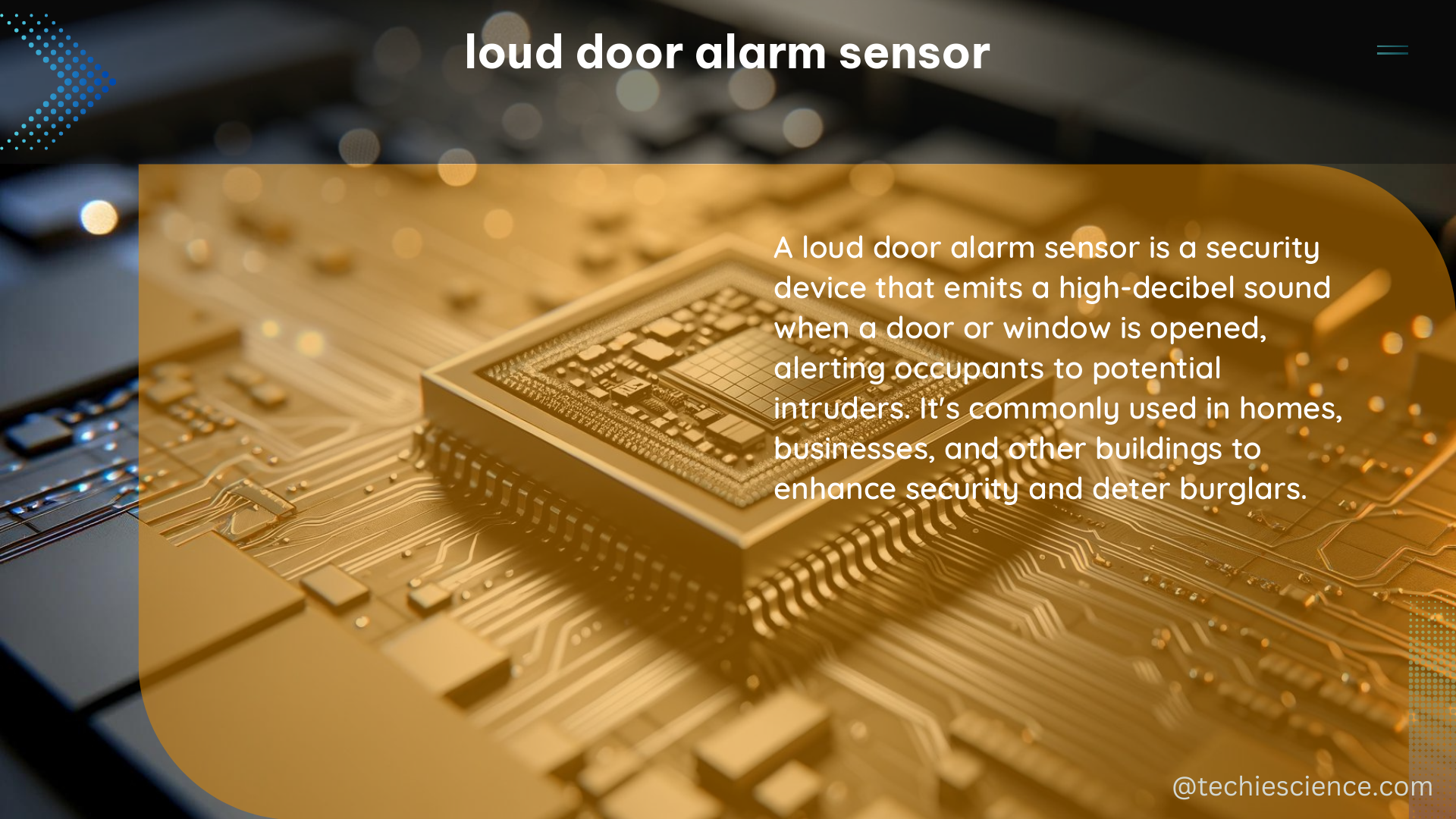The loud door alarm sensor is a crucial component in home security systems, providing a high-decibel alert when a door is opened. These sensors are designed to deter unwanted entries and promptly notify homeowners of potential intruders, ensuring the safety and security of your property.
Understanding the Technical Specifications
The loud door alarm sensor typically features a 120 dB alarm, which is audible from a distance of over 750 feet. This level of sound intensity is comparable to the noise generated by a jet engine at takeoff, making it highly effective in grabbing the attention of both the homeowner and potential intruders.
The sensor is powered by LR44 batteries, which have a lifespan of 6 to 12 months, depending on the frequency of use. This wireless design eliminates the need for complex wiring during installation, making it a convenient and versatile option for DIY home security enthusiasts.
| Specification | Value |
|---|---|
| Alarm Volume | 120 dB |
| Audible Range | 750+ feet |
| Battery Type | LR44 |
| Battery Life | 6-12 months |
| Wireless | Yes |
| Installation | Adhesive-based |
Configuring the Alarm Delay

One of the key features of the loud door alarm sensor is the ability to configure a delay before the alarm is triggered. This delay can be set to 30 seconds, allowing the first person arriving home to disarm the system before the alarm is activated.
This delay function is particularly useful for homeowners who have a routine of entering and exiting their homes, as it prevents the alarm from being triggered unnecessarily. It also provides a grace period for family members or authorized individuals to enter the home without setting off the alarm.
To configure the alarm delay, you can follow the instructions provided by the manufacturer or refer to community-based resources, such as the Home Assistant forum post mentioned in the initial answer.
Integrating with Smart Home Systems
For DIY enthusiasts, the loud door alarm sensor can be seamlessly integrated with smart home systems, such as Home Assistant, to create custom automation rules. This integration allows for a more sophisticated and personalized home security setup.
One example of a custom automation rule would be to trigger the alarm when a door is opened and there is no one home. This automation can also include the aforementioned delay before the alarm is triggered, providing time for the first person arriving home to disarm the system.
By leveraging smart home integration, homeowners can tailor the alarm sensor’s behavior to their specific needs and preferences, enhancing the overall security and convenience of their home.
Installation and Placement
The loud door alarm sensor is designed for easy installation, as it utilizes an adhesive-based mounting system. This allows the sensor to be placed on any door or opening, without the need for complex wiring or drilling.
When selecting the placement of the sensor, it’s important to consider the following factors:
- Door Accessibility: Ensure the sensor is positioned in a location that is easily accessible for both arming and disarming the system.
- Visibility: Place the sensor in a prominent location where it can be easily seen, as the visual cue can serve as a deterrent for potential intruders.
- Proximity to Alarm: Position the sensor close to the main alarm system or control panel to ensure a seamless integration and response.
- Interference Avoidance: Avoid placing the sensor near sources of electromagnetic interference, such as electrical appliances or wireless devices, to maintain optimal performance.
By carefully considering these placement factors, you can ensure the loud door alarm sensor is installed in the most effective and efficient manner, maximizing its security benefits for your home.
Maintenance and Battery Replacement
To maintain the optimal performance of the loud door alarm sensor, it’s essential to regularly check the battery level and replace the batteries when necessary. As mentioned earlier, the LR44 batteries typically have a lifespan of 6 to 12 months, depending on the frequency of use.
When replacing the batteries, be sure to follow the manufacturer’s instructions carefully. This may involve removing the sensor from the door, accessing the battery compartment, and inserting the new batteries with the correct orientation.
It’s also a good practice to test the alarm functionality after battery replacement to ensure the sensor is still operating correctly. This can be done by triggering the sensor and verifying that the loud alarm is activated as expected.
Conclusion
The loud door alarm sensor is a powerful and versatile tool for enhancing the security of your home. With its high-decibel alarm, wireless design, and integration capabilities with smart home systems, this sensor provides a comprehensive solution for deterring unwanted entries and alerting homeowners of potential intruders.
By understanding the technical specifications, configuring the alarm delay, and properly installing and maintaining the sensor, DIY home security enthusiasts can create a tailored and effective security system that meets their specific needs and preferences.
Remember, the key to a successful home security setup is a combination of reliable hardware, smart automation, and vigilant monitoring. The loud door alarm sensor is a crucial component in this equation, offering a reliable and audible line of defense against potential threats.
References:
– Home Assistant Community Post on Alarm Sensor Delay
– Battery-Operated Loud Door Alarm Sensor on Amazon
– OSHA Noise Exposure Guidelines

The lambdageeks.com Core SME Team is a group of experienced subject matter experts from diverse scientific and technical fields including Physics, Chemistry, Technology,Electronics & Electrical Engineering, Automotive, Mechanical Engineering. Our team collaborates to create high-quality, well-researched articles on a wide range of science and technology topics for the lambdageeks.com website.
All Our Senior SME are having more than 7 Years of experience in the respective fields . They are either Working Industry Professionals or assocaited With different Universities. Refer Our Authors Page to get to know About our Core SMEs.